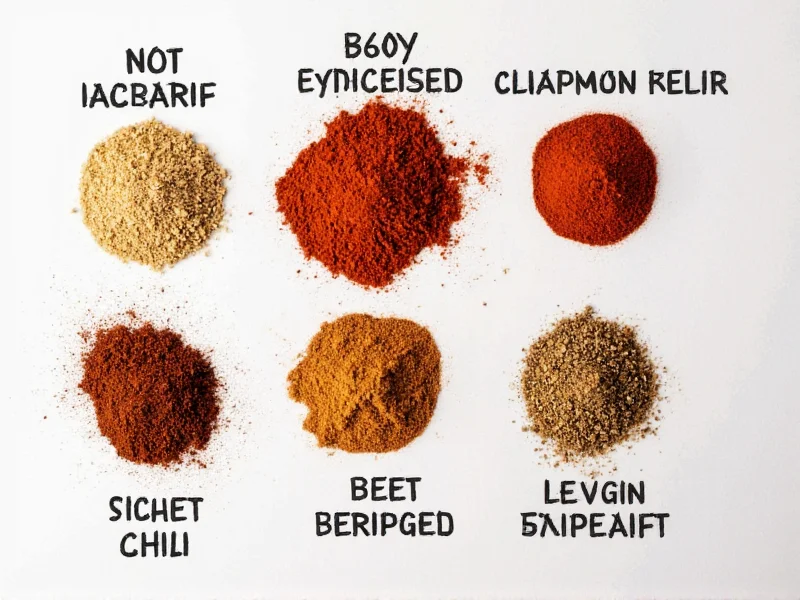Creating the perfect chili depends on understanding how spices work together to build complex, balanced flavors. While recipes vary by region and personal taste, certain spices form the foundation of authentic chili seasoning. This guide explores not just which spices to use, but how they interact, optimal proportions, and regional variations that can transform your chili from ordinary to extraordinary.
Core Spices Every Chili Needs
These six spices create the essential flavor profile for traditional chili. Understanding their individual contributions helps you adjust recipes to your taste preferences while maintaining authentic character.
| Spice | Flavor Profile | Essential Role in Chili | Starting Proportion (per lb meat) |
|---|---|---|---|
| Chili Powder | Earthy, slightly sweet, moderate heat | Provides base flavor and characteristic red color | 2 tablespoons |
| Cumin | Earthy, warm, slightly smoky | Creates depth and authentic Southwestern character | 1 tablespoon |
| Paprika | Sweet, mild pepper flavor | Enhances color and adds subtle sweetness | 1 teaspoon |
| Garlic Powder | Pungent, savory | Adds umami depth without raw garlic bite | 1 teaspoon |
| Onion Powder | Sweet, savory | Complements garlic and enhances meatiness | 1 teaspoon |
| Dried Oregano | Herbaceous, slightly bitter | Provides authentic Tex-Mex herbal note | 1/2 teaspoon |
Secondary Spices for Flavor Enhancement
Once you've mastered the core blend, these additional spices can elevate your chili to restaurant quality. Add them gradually, tasting as you go, to avoid overpowering the base flavors.
- Cayenne pepper (1/8-1/4 tsp): Increases heat without altering flavor profile significantly. Add early for integrated heat, late for sharper kick.
- Black pepper (1/2 tsp): Adds subtle complexity and enhances other spices. Freshly ground works best.
- Coriander (1/2 tsp): Citrusy notes that balance earthy spices. Particularly effective in vegetarian chili recipes.
- Cinnamon (1/8 tsp): Tiny amount adds warmth and depth without tasting sweet. Essential in Cincinnati-style chili.
- Unsweetened cocoa powder (1 tsp): Deepens color and adds subtle richness that complements chili's earthiness.
Mastering Spice Proportions and Timing
Professional chefs know that spice proportions and when you add them matter as much as which spices you use. Follow these guidelines for perfectly balanced chili every time.
For the most complex flavor development, bloom your spices in oil before adding liquids. Heat 1-2 tablespoons of oil in your pot, add spices, and stir constantly for 30-60 seconds until fragrant. This process activates essential oils and creates deeper flavor compounds. Then proceed with your recipe.
When adjusting spice levels, remember that chili's flavors continue developing as it simmers and even after refrigeration. Always under-season initially—you can add more spice later, but you can't remove it once added. For best results, prepare chili a day ahead; flavors meld beautifully overnight.
Regional Variations in Chili Spices
Chili recipes vary dramatically by region, each with distinctive spice profiles. Understanding these differences helps you create authentic regional styles or blend elements to create your signature version.
| Regional Style | Signature Spice Characteristics | Unique Spice Elements |
|---|---|---|
| Texas Red | Meat-forward, minimal spices | Heavy on chili powder and cumin, no beans, minimal paprika |
| New Mexico | Authentic, complex heat | Uses regional dried chilies (Hatch, Anaheim), less cumin, more oregano |
| Cincinnati | Sweet-spicy with Mediterranean influence | Cinnamon, allspice, sometimes chocolate, served over spaghetti |
| Vegetarian/Vegan | Rich umami without meat | Extra smoked paprika, liquid smoke, cocoa powder, nutritional yeast |
Fresh vs. Dried Spices: When to Use Each
While dried spices form the backbone of most chili recipes, fresh ingredients can add dimension when used strategically. Understanding when to use each type creates more nuanced flavor.
Dried spices generally provide more concentrated, consistent flavor and better withstand long simmering times. However, fresh garlic and onion added early in cooking can create a more complex base than their powdered counterparts. For finishing touches, consider adding fresh cilantro or a squeeze of lime juice just before serving to brighten flavors.
Proper storage maintains spice potency. Keep spices in airtight containers away from light and heat. Most ground spices retain optimal flavor for 6-12 months, while whole spices last 1-2 years. Test your spices by rubbing a small amount between fingers—if the aroma is weak, it's time to replace them.
Common Spice Mistakes to Avoid
Even experienced cooks make these spice-related errors that compromise chili quality:
- Adding all spices at once: Different spices benefit from different addition times. Earthy spices (cumin, chili powder) should bloom early, while delicate flavors (oregano) work better added in the last 30 minutes.
- Over-relying on pre-mixed blends: Commercial chili seasoning often contains excessive salt and fillers. Creating your own blend gives better control over flavor balance.
- Not toasting whole spices: For maximum flavor, toast whole cumin seeds or dried chilies before grinding. This simple step dramatically enhances depth.
- Ignoring acid balance: Spices need acid to shine. Add a splash of vinegar, lime juice, or tomato paste to brighten spice flavors.
- Using expired spices: Old spices lack potency, leading to flat flavor that prompts overuse and imbalance.
Creating Your Perfect Spice Blend
The best chili spice combination reflects your personal taste preferences. Start with the foundational ratios, then adjust systematically:
- Prepare chili using the base proportions
- After initial simmer, remove a small portion for tasting
- Add one additional spice at a time in 1/8 teaspoon increments
- Wait 10 minutes between additions to allow flavors to integrate
- Document your adjustments for future reference
Remember that dietary preferences affect spice balance. Vegetarian chili spice ratios often benefit from extra smoked paprika and cumin to compensate for lack of meat depth, while mild chili spice alternatives can use sweet paprika instead of cayenne while maintaining complexity.











 浙公网安备
33010002000092号
浙公网安备
33010002000092号 浙B2-20120091-4
浙B2-20120091-4